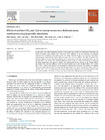Effects of ambient CO2 and H2O on soot processes in n-dodecane spray combustion using large eddy simulation

Open access
Date
2022-03-15Type
- Journal Article
Abstract
In this study, large eddy simulations, coupled a two-equation soot model, are performed to investigate the effects of ambient carbon dioxide (CO2) and water (H2O) additions on the soot formation and oxidation processes in an n-dodecane spray flame. In the soot model, acetylene (C2H2) is soot precursor and surface growth species, while hydroxyl radical (OH) and oxygen (O2) are soot oxidizers. The effect of ambient CO2 and H2O additions on soot formation/oxidation can be separated into thermal and chemical effects. For the thermal effects, the ambient CO2 and H2O additions increase C2H2 but reduce OH formation by lowering the flame temperature. This leads to a higher soot mass formed. On the contrary to the thermal effects, the ambient CO2 and H2O additions reduce the soot formation due to their chemical effects. The reaction CH2∗+CO2↔CH2O+CO is found to be responsible for reducing C2H2 formation. The ambient H2O addition results in a higher OH but lower the C2H2 mass formed owing to the reverse reactions H2+OH↔H2O+H and OH+OH↔H2O+O. Furthermore, the chemical effects is more significant than the thermal effects under the tested conditions. This leads to a lower soot mass formed when adding ambient CO2 and H2O. Show more
Permanent link
https://doi.org/10.3929/ethz-b-000522268Publication status
publishedExternal links
Journal / series
FuelVolume
Pages / Article No.
Publisher
ElsevierSubject
Spray A; Soot processes; CO2 addition; H2O addition; LESMore
Show all metadata


